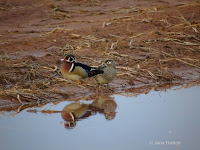WOOD DUCK
WOOD DUCK – (Aix sponsa) – (See images below)
DESCRIPTION: The Wood Duck The drake is VERY colorful, starting with an iridescent green head with white lines, a white throat, a rusty breast mottled with light grey, grey under parts, beige sides, with black on the wings and tail and a dark green back. The wings are adapted for flying among trees. The bill is red, white, black and orange at the base. The eyes are red, and the legs orange. The female has duller colors. The head is boxy and crested in both sexes. This duck is approximately 50 cm (20 inches) long.
VOICE: https://www.xeno-canto.org/species/Aix-sponsa
NAME: The English name ‘Duck’ is from Anglo-saxon ‘duce’ and means ‘diver’. The wood duck, as the name implies, lives in the woods. The Latin genus name ‘Aix’ is from Greek and refers to a ‘waterfowl’. As for the Latin species name ‘Sponsa’, it means ‘bethroted’, in reference to the drake’s attractive appearance.
HABITAT: Forests with wetlands such as marshes and beaver ponds.
DIET: As with other duck species, the wood duck feeds on vegetation and insects in the water, but also on grain in fields, and tree seeds and acorns in the forest.
NESTING: This duck nests in tree holes, and will also use nest boxes if available. Between five and fifteen light beige eggs are laid, which are incubated by the female. Not long after hatching, ducklings climb out of the nest and jump to the ground. The mother takes care of them.
DISTRIBUTION: It migrates to the south central USA and Mexico for the winter. It is a year-round resident for the eastern half of the USA as well. It also can be found in Europe, as per the photo below by Frank Vassen, Brussels.
Distribution map: https://en.wikipedia.org/wiki/Wood_duck#/media/File:Aix_sponsa_dis1.PNG
ON PEI: The wood duck breeds on Prince Edward Island and is listed as ‘fairly common’ except in the winter.
CONSERVATION: There has been an increase in the population of this duck over the last few decades, and the species is currently not considered at risk. There are also initiatives to provide nesting boxes for this duck.
NOTES: The wood duck is a perching duck, i.e. it will perch on trees in the forest.
SIMILAR SPECIES: Mandarin Duck – this duck and the wood duck are the only two members of the genus ‘Aix’.
REFERENCES: https://en.wikipedia.org/wiki/Wood_duck
http://www.hww.ca/en/wildlife/birds/wood-duck.html (Hinterland Who’s Who)
https://www.audubon.org/field-guide/bird/wood-duck
https://www.allaboutbirds.org/guide/Wood_Duck/id
https://www.borealbirds.org/bird/wood-duck
https://www.mba-aom.ca/jsp/toc.jsp (Maritimes Breeding Bird Atlas)
Ducks Unlimited Canada (Wood Duck)
https://nature.mdc.mo.gov/discover-nature/field-guide/wood-duck (Missouri Department of Conservation)
DESCRIPTION: The Wood Duck The drake is VERY colorful, starting with an iridescent green head with white lines, a white throat, a rusty breast mottled with light grey, grey under parts, beige sides, with black on the wings and tail and a dark green back. The wings are adapted for flying among trees. The bill is red, white, black and orange at the base. The eyes are red, and the legs orange. The female has duller colors. The head is boxy and crested in both sexes. This duck is approximately 50 cm (20 inches) long.
VOICE: https://www.xeno-canto.org/species/Aix-sponsa
NAME: The English name ‘Duck’ is from Anglo-saxon ‘duce’ and means ‘diver’. The wood duck, as the name implies, lives in the woods. The Latin genus name ‘Aix’ is from Greek and refers to a ‘waterfowl’. As for the Latin species name ‘Sponsa’, it means ‘bethroted’, in reference to the drake’s attractive appearance.
HABITAT: Forests with wetlands such as marshes and beaver ponds.
DIET: As with other duck species, the wood duck feeds on vegetation and insects in the water, but also on grain in fields, and tree seeds and acorns in the forest.
NESTING: This duck nests in tree holes, and will also use nest boxes if available. Between five and fifteen light beige eggs are laid, which are incubated by the female. Not long after hatching, ducklings climb out of the nest and jump to the ground. The mother takes care of them.
DISTRIBUTION: It migrates to the south central USA and Mexico for the winter. It is a year-round resident for the eastern half of the USA as well. It also can be found in Europe, as per the photo below by Frank Vassen, Brussels.
Distribution map: https://en.wikipedia.org/wiki/Wood_duck#/media/File:Aix_sponsa_dis1.PNG
ON PEI: The wood duck breeds on Prince Edward Island and is listed as ‘fairly common’ except in the winter.
CONSERVATION: There has been an increase in the population of this duck over the last few decades, and the species is currently not considered at risk. There are also initiatives to provide nesting boxes for this duck.
NOTES: The wood duck is a perching duck, i.e. it will perch on trees in the forest.
SIMILAR SPECIES: Mandarin Duck – this duck and the wood duck are the only two members of the genus ‘Aix’.
REFERENCES: https://en.wikipedia.org/wiki/Wood_duck
http://www.hww.ca/en/wildlife/birds/wood-duck.html (Hinterland Who’s Who)
https://www.audubon.org/field-guide/bird/wood-duck
https://www.allaboutbirds.org/guide/Wood_Duck/id
https://www.borealbirds.org/bird/wood-duck
https://www.mba-aom.ca/jsp/toc.jsp (Maritimes Breeding Bird Atlas)
Ducks Unlimited Canada (Wood Duck)
https://nature.mdc.mo.gov/discover-nature/field-guide/wood-duck (Missouri Department of Conservation)
 |
| Wood duck male, Brussels, Frank Vassen |
 |
| Wood duck pair, PEI, by Jane Hanlon |
 |
| Wood duck drake, PEI, by Matt Beardsley |